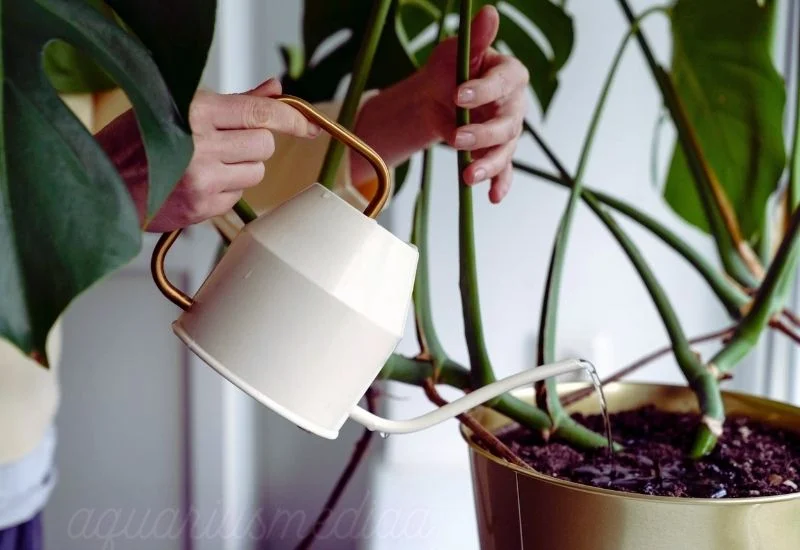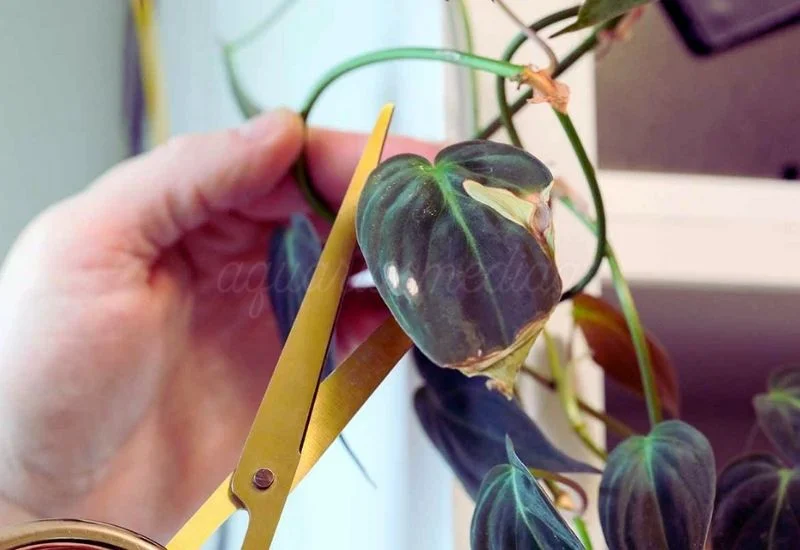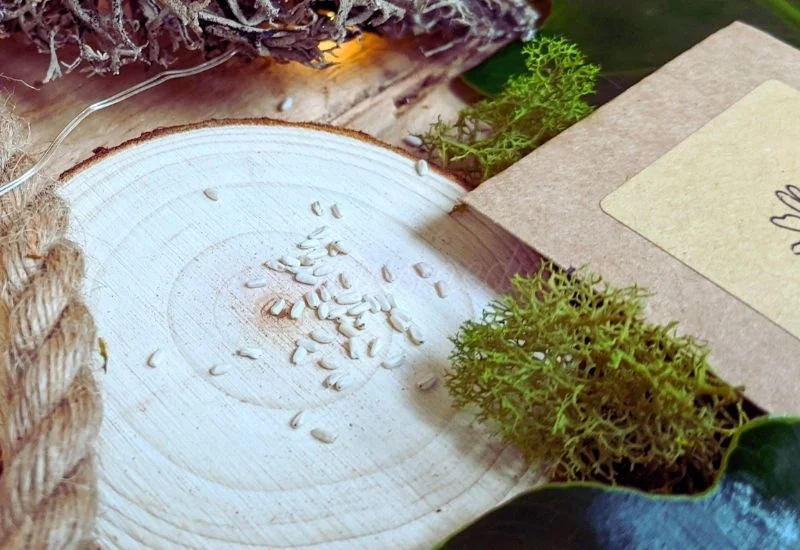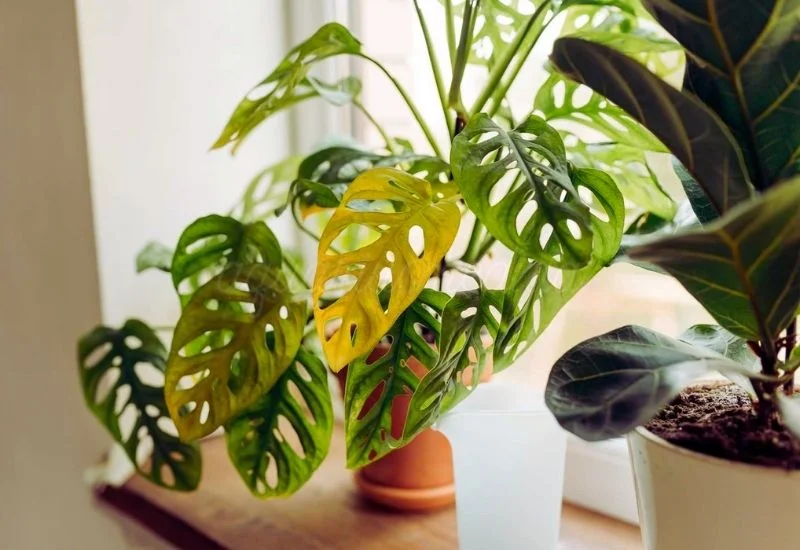In this blog post, you are going to learn all useful information about Split Leaf Philodendron.
From interesting facts, toxicity, benefits, care guide, propagation to repotting, common problems, types, and similar plants, all I have covered in this ultimate guide.
Let’s Start
Overview of Split Leaf Philodendron
Split Leaf Philodendron is a beautiful indoor plant. Its leaves are large, glossy, and distinctively split. This tropical plant requires warm climatic conditions. It includes flowering plants, though it is known for its leaves. This plant produces flowers when it reaches 15-20 years.
Before 2018, scientists consider this plant a sub-genus of Meconostigma. But later, due to its anatomical differences, it was reclassified into a separate genus named “Thaumatophyllum.”
As this Philodendron is a tropical plant, it originates from the rainforests of South America. Due to its increase in popularity, it spreads to Brazil, Argentina, Paraguay, Bolivia, North America, and Central America.
| Common Name | Ceriman, Cutleaf Philodendron, Hurricane Plant, Mexican Breadfruit, Swiss Cheese Plant, Horsehead Philodendron, Lacy Tree Philodendron, Selloum |
| Botanical Name | Thaumatophyllum bipinnatifidum |
| Family | Araceae |
| Plant Type | Household Plant |
| Fruit | No |
| Mature Size | Tall up to 3 m, Wide up to 4.5 m |
| Sun Exposure | 6 to 8 hours of Indirect sunlight |
| Soil Type | Porous and lightweight |
| Soil pH | 5.5 to 6.5 |
| Native Area | South America |
| Toxic | Yes |
| Growth | Fast growth |
| Hardiness Zone | 8 – 11 |
Leaves
This plant has large, heart-shaped leaves that have characteristic perforations. Their holes, called slits, increase their size with time. The maximum size of leaves is up to 1.5 meters in length. Its glossy leaves are shining and lobbed from the center.
Stems
There is a large central stem that is strong enough to support not only themselves but also their large leaves. It can reach up to six feet in indoor places.
The leaf stems are also thick and strong, which keeps them in an upright position.
Toxicity
The sap of the Split Leaf Philodendron contains calcium oxalate. Although this chemical is not fatal, it can cause serious issues in humans, dogs, cats, and other animals.
Benefits
This indoor plant has an attractive appearance. So, along with its natural air cleaning benefit, it will be a beautiful masterpiece in your room.
This plant is very easy to maintain. Moreover, it shows immediate results of your efforts in the form of rapid growth.
Care guide
The size of the Split Leaf Plant is directly proportional to the size of the pot. Therefore, you must select a bigger pot. So, the leaves will grow larger, and the roots will find enough space for expansion.
Moreover, consider the Spring and Summer seasons if you want to add this plant to your indoor plants.
Don’t worry about caring for the Split Leaf plant. You can achieve optimum growth of this plant by fulfilling the conditions below.
Placing

The foremost condition for the Split leaf plant is the placement. Its native area has a high level of humidity. So you should place your plant in a well-lit and highly humid place.
At home, you can place this plant in the living room, bathroom, or your home jungle. The key tip during placement is that your plant must be in the window facing south or east.
Watering

This plant needs moist soil but not enough to cause waterlogging. Young Split leaf plants require more water, so water them quickly after the top inch of the soil becomes dry. However, wait for the above two to three inches of soil to dry for larger plants.
You can install moisture meters in the pot’s soil or check by touching your finger to the top layer of the soil.
Soil

Split-leaf philodendrons need soil that holds the required moisture and drains extra water. To make such soil, you need to balance the constituents. One of the most effective soil mixtures contains the following constituents.
- Potting soil
- Perlite
- Coconut coir
- Bark
Perlite will make your soil porous. Coconut coir will hold water, and the bark will improve drainage.
Light
Split Leaf Philodendron requires a minimum of six hours of indirect sunlight. In its native area, this plant grows in direct sunlight, but the weather conditions must be moderate.
This plant grows larger in direct sunlight and smaller in indirect sunlight. So, to put your plant in direct sunlight, start with a few hours and slowly increase them.
Temperature and Humidity
For optimum plant growth, you have to maintain high temperatures and high levels of humidity.
The ideal temperature range for Split Leaf is 65 to 80°F ( 18 to 26°C). However, temperatures should never be below 50°F ( 10 °C ).
The humidity level should range between 60 to 70 % for this plant. Otherwise, the plant leaves may turn brown. In the house, you have to place this plant in the most humid area which is your kitchen.
Fertilizers

There are several necessary nutrients for a plant, including nitrogen, phosphorus, potassium, calcium, magnesium, and small quantities of boron and iron. Pot soil provides these nutrients. Over time, this potting soil should be replenished with these nutrients through fertilizers.
For Split Leaf Philodendron, water-soluble and slow-release fertilizers are typically used. They are added during weekly watering. However, if you are regularly repotting after a certain time period, this plant will not require any fertilizer.
The best times to provide fertilizers are spring and summer, which are the times of maximum growth. But first, analyze whether the plant really needs fertilizers. The best and most obvious sign of nutrient deficiency is stunted growth.
Pruning

This Philodendron has large leaves and can grow like a vine if left unchecked. Moreover, there may be some dead, brown, or yellow leaves. They need to be removed from the stem.
Firstly, spot the leaves that need to be trimmed. Use a sharp and clean scissor to cut the leaves. Try to cut the leaves without damaging the nodes. These nodes will produce new leaves.
Spring and fall are the best times to prune. After pruning, your plant will be ready to give birth to new leaves.
Propagation

Although the Split Leaf plant produces seeds, they propagate through its stem parts. You can divide the whole plant into two or cut a small part and use it for propagation. However, most people use stem cuttings for propagation as these provide the most rapid growth.
By Seed

Seeds are very rare in this plant. They produce seeds when they are 15-20 years old. Moreover, your plant will not produce seeds due to the indoor growth.
However, if you want to germinate seeds, you can put them in the ideal soil mixture. You have to ensure the soil mixture around the seed is damp or moist until the roots sprout. According to some gardeners, it can take a month to produce roots.
By Stem Cutting
- First of all, select a healthy, good-looking, and full-grown Split Leaf plant.
- Then, cut a small part of about six inches but at an angle for maximum surface area. Now, you can keep this cutting in the water and wait for the roots to form. Or wait for the callous formation.
- Now prepare the potting soil as described above. Damp this soil and make a hole with your finger in the soft soil.
- For rapid growth, you can use growth hormone. Simply dip your cutting in the hormone and then put it in the hole.
Now you are done with the propagation. As it is a baby plant, you have to maintain high humidity and high temperature. It will take up to three weeks to develop roots.
Repotting
You usually have to repot your plant after a year or two. However, there are some clear signs for the time of repotting. The very first sign is the circling of roots. The net of the roots starts sprouting from the drainage holes. This shows that the plant needs to be repotted. Here are some easy steps to follow to report your cut-leaf Philodendron.
- Choose a pot two inches larger in size. There must be proper holes for draining extra water in the pot.
- Now, you have to remove the plant from its pot without damaging the roots carefully. Tilt the pot and pour the soil outside. Try to pull out the plant with its root system intact. If there are dead roots, you can trim them with sharp scissors.
- Make a bottom layer of the soil in the new pot. Then, hold the plant in the center of the pot and fill the pot with the soil around that plant.
Now you are done with repotting. Ensure that the soil remains moist in the starting days. Avoid any harsh conditions such as high or low temperature, direct sunlight, or over-watering.
Common Problems
Yellowing of Leaves

Yellowing of the leaves is mostly caused by the aging. Aged leaves become yellow and dry. So if it is due to aging, you can simply trim them from the plant.
However, overwatering can also cause yellowing of the leaves. As extra water will cause rotting of the roots, indirectly damaging the food transport system of the plant. Leaves will not receive enough food and will turn yellow.
Treatment of leaf yellowing is not easy. You may need to report and remove the damaged roots from the plant.
Brown Leaves or Wilting
Direct sunlight for a prolonged period of time can cause the leaves to turn brown. This is caused by the sun burning, just like human skin. Some of the tissues of the leaves die and give a dry and brownish appearance.
Place the plant in indirect sunlight or increase humidity to prevent wilting.
Pests and Fungus
There are a number of pests and insects which can damage this Philodendron. These include the aphids, mealybugs, scales, spider mites, moths, fungus gnats, and thrips. They can suck the moisture or nutrients from the sap and let it dry.
Aphids result in the discoloration, wilting, or death of plants. Neem oil or a diluted mixture of dish soap and water are very effective sprays for killing the aphids.
Unbalanced Growth
Sometimes, plants show more growth in the direction of sunlight to increase the surface area. So, you can place your plant in a place that provides equal sunlight for all the parts of the plant.
Companion Plants
Everyone wants to diversify their garden with different plants. If you want to add a variety of plants, you should select the plants that can grow under the same conditions. So it will be very easy for you to care for them.
- Ivy
- Peace lily
- Bow Hemp
The above-mentioned plants will easily grow along with the Split Leaf Philodendron.
Alternative plants
Many people search for house plants that have the same appearance of Split Leaf but are not toxic. So here are some non-toxic plants.
- Money Tree Plant
- Lady Palm
- Coconut Palm
These plants also have large, green, and attractive leaves. Moreover, these are pet-friendly plants.
Monstera vs Split Leaf Philodendron
| Features | Monstera | Split Leaf Philodendron |
| Scientific names | Monstera deliciosa | Thaumatophyllum bipinnatifidum |
| Leaves size | Length = 3 feet Width = 2 feet | Length = max 3 feet Width = one feet |
| Leaves shape | Heart-shaped leaves with holes called fenestrations | Heart-shaped leaves that split into leafy fingers |
| Fruit | Large, Oblong berry shape, greenish-white color, scales on its surface | No fruit |
| Growth | Slower growth | Faster growth |
| Plant size | 60 feet tall | 15 feet tall |
| Native area | Southern Mexico | Central and South America |
Here you have it:
A lot of information about Split Leaf Philodendron.
What’s your next step?
Either buying or caring if you already have?
Let me know in the comment section.
